The Calendar of the Yearly Festivals
139 139 Ōwasami-no-Mikoto Shrine
Tottori City Nakasunami (Ōyudana)

Picture of the Kirin’s Head
Picture of the Shoujou’s Mask
| Date of the Festival | Second Sunday of October |
|---|---|
| Time for the Kirin Dance at the Shrine | 9 a.m. at both locations of <139>and<140> |
| Origin | Around the late Edo period |
| Characteristics | The Kirin dance was designated as an Intangible Folk Cultural Property of Tottori Prefecture in 1959. A grand festival is held every 5 years. The Kirin’s head, crafted around 1660, was designated as a Cultural Heritage under protection of Tottori Prefecture. |
| Area | Tottori City Nakasunami (Ōyudana) |
Introduction to the Shrine
Ōwasami-no-Mikoto Shrine
The year of the shrine's founding is unknown. According to an entry in the history text "Nihon Sandai Jitsuroku", the shrine's deity "Ōwasami of Inaba Province" was granted the 14th rank on June of Jōgan 7 (865). The shrine is listed in the "Engishiki", a book of laws and customs compiled in 927, as “Ōwasami-no-mikoto Shrine”.
■Deity of the Shrine
Ōwasami-no-Mikoto, Kuninotokotachi-no-Kami, Toyogumonu-no-Kami, Uhijini-no-Kami, Suhijini-no-Kami, Tsunogui-no-Kami, Ikigui-no-Kami, Ōtonoji-no-Kami, Ōtonobe-no-Kami, Omodaruo-Kami, Ayakashikone-no-Kami, Izanagi-no-Kami, Izanami-no-Kami, Amaterasu-Ōmikami, Ame-no-oshihomimi-no-Kami, Ninigi-no-Mikoto
■cultural property
[Kirin Dance]
Designated as a Tottori Prefecture Intangible Folk Cultural Property in 1959.
Designated as a National Important Intangible Folk Cultural Property in 2020.
[The Kirin’s Head in Ōyudana District]
The wooden head of the Kirin was designated as a Protected Cultural Heritage of Tottori Prefecture in 1954. It was crafted in the mid-Edo period.
Access to the Shrine
Kamisunami 674, Tottori City, Tottori Prefecture(MAP)
A five-minute walk from "Kamisunami" bus stop on the Kando Bus Line.
Related Information
Sites Associated with the Kirin Dances
Monuments around the Tottori Station
-
Wooden Benches
-
Sand Sculpture of Kirin
-
Stone Sculpture of Kirin
-
Tottori Toshogu in the Ouchidani Park
Tottori Toshogu was established by Mitsunaka Ikeda, a local lord, in the 17th century, and is a branch shrine of Nikko Toshogu. The shrine inherits the initial Kirin, which is now stored in the Tottori Prefectural Museum. During Gongen Matsuri, a festival in October, members of the Inaba Kirin Dance Club dance before the shrine’s deity, and a procession of a mikoshi (portable shrine) walks through to animate the festival.
-
The Imeitei Pioneer Memorial Gallery of Hamasaka
Imeitei is a gallery remodeled by Shichikamaya Yashiki (Shichikamaya Mansion) of the Mori family, who until lately ran a sake-brewery. It is a historical and folk gallery where visitors can trace the footsteps of the pioneers living around the Shin-onsen Town. The head of the Kirin from the Utsuno Shrine is displayed in the gallery. It is designated as the town’s cultural heritage.
-
Sora no Eki Park (Sky Station Park) at the Amarube Bridge
The origin of the Kirin from the Junisha Shrine, a shrine in adjacent to the Yoroi district, is the Kirin dance performed in the Iwami Town. This dance was a part of the inauguration of the Amarube Bridge at the end of the Meiji period. Visitors can see children’s drawings of the Kirin displayed in Sora no Eki at the Amarube Bridge and the park at the foot of the Amarube Crystal Tower. The roadside stations in vicinity are also worth sightseeing.



